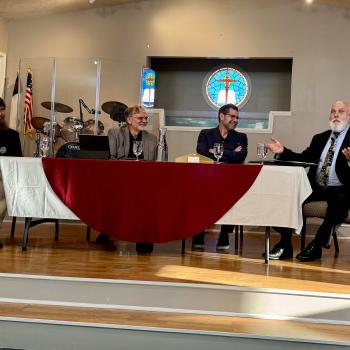In a play off the now unpracticed Mormon doctrine of polygamous eternal marriage, Graham's missionaries also promise their victims immortality along with sister wives, a very similar image to Dracula's own coven of un-dead vampiresses. (See James D'Arc, "The Mormon as Vampire: A Comparative Study of Winifred Graham's The Love Story of a Mormon, the Film Trapped by the Mormons, and Bram Stoker's Dracula," BYU Studies. 46:2 (2007), 169-179.)
Winifred Graham's novels particularly emphasized the similarity between a vampire's and a missionary's sexual insatiability. Where Dracula pursues young women to join the ranks of his undead harem, Graham's Mormon missionaries pursue young women to entrap them in a polygamous eternal marriage. The problem with Graham's pivotal point, however, was that polygamy had been officially banned in the Mormon church for over a decade when she started publishing her sensational novels. Graham's vampire-like polygamous Mormons capitalized not on the actual, official theology of the LDS church, but rather on a generally believed stereotype of Mormon sexuality that was bandied about in the early 20th century.
Here, then, we have two examples of vampire or vampire-like characters representing what society at large assumes to be the sexual theology of Mormonism. However, the theologies each of these examples represents are, fascinatingly enough, more or less the opposite of each other. The early Mormon characters of Winifred Graham are insatiable sexual predators while the modern "Mormon" Edward Cullen is constantly rejecting the temptation of sex in favor of abstinence followed by an eternal monogamy. (In the fourth book, he first marries Bella and then makes her an immortal vampire at her own insistence.) In both cases, the vampire is Mormon or the Mormon is vampire. In both cases, the vampire represents assumptions about the sexual theology of Mormonism.
Obviously, though these two stereotypes -- the polygamist vs. the abstinent monogamist -- are at variance with each other, they supposedly represent the same thing, Mormon sexuality. As seen through the pop culture of vampire books and film, social assumptions about Mormonism have drastically changed in the past century. Where Mormons used to be seen as sexually deviant and excessive, now they are considered to be vastly conservative.
There is, however, one enduring similarity between these Mormon vampires of the past and present that should not be overlooked: virility. Mormons have always been stereotyped as a particularly fertile people, whether it was through the polygamous families of the 19th century or the church-going monogamous pair with ten children in tow. Earlier vampire Mormons were obviously polygamous and insatiable, fulfilling that stereotype quite openly. Edward Cullen, too, exhibits some aspect of the Mormon fertility stereotype as he and his new wife, Bella, become pregnant during only their second sexual encounter. Furthermore, Edward's child develops so quickly that Bella's stomach is noticeably larger in only five days. If Edward is the socially stereotyped Mormon in his abstinence, so he continues to be the stereotyped Mormon in his particularly potent virility.
To be sure, the vampire-missionaries of Winifred Graham's anti-Mormon novels were sensational and propagandistic while Meyer's Twilight series sets out to be anything but blatantly referential toward Mormonism. Yet, the connections are still made today between Edward, his sexuality, and Meyer's faith. The vampire again has become the symbol of that which is both sexualized and mysterious. To the readers and theatergoers of the early 20th century, Mormonism's connections to polygamy made its members seem dangerously charismatic and foreign. To the readers and theatergoers of the 21st century, Mormonism's doctrine of abstinence is what now sets the religion apart from mainstream hook-ups and one night stands. The vampire is still there -- he just may look a little different. Less dangerous, perhaps. More romantically inclined, sure. But, still, he's a Mormon.
Heidi Harris recently completed her M.A. in American Studies from Boston University where she focused on 19th-century cultural history, religion, and gender. Currently, she lives in Coos Bay, Oregon where she teaches introductory philosophy and explores tide pools with her marine biologist husband, Paul.




